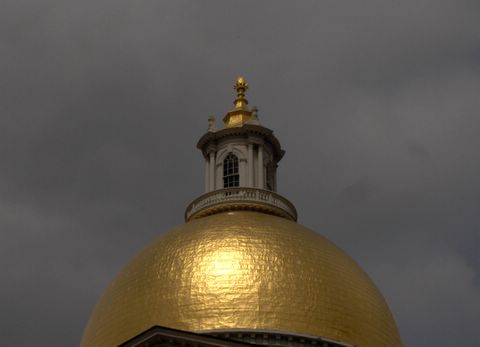
You cannot miss this golden dome, which is used as a landmark by many Bostonians. It belongs to the Massachusetts State House and overlooks the “Boston Common” on “Beacon Hill”. Designed by Charles Bulfinch in 1798, the dome went through different colors; it was painted gray, light yellow, and then repainted dull gray again during World War II to hide itself from the enemy ships. Finally in 1874 the dome was covered with 23.5 karat gold leaves. To keep it bright and shiny it is redone every 25 years. If you look closely you can see at the top a golden pinecone, which is the symbol of the abundant forests that the early settlers exploited in Massachusetts.
Vous ne pouvez pas rater ce dôme doré qui sert de point de repère aux Bostoniens. Il fait partie du Massachusetts State House à “Beacon Hill” qui surplombe le “Boston Common”. Crée par Charles Bulfinch en 1798, le dôme est passé par différentes couleurs; il a été d’abord peint en gris puis jaune clair, et repeint en gris foncé pendant la deuxième guerre mondiale pour ne pas être la cible des bateaux ennemis. Enfin en 1874, le dôme fut doré à la feuille d’or 23.5 carats. Pour garder son éclat et son reflet brillant, cette opération est renouvelée tous les 25 ans. Si vous regardez de plus prêt, vous pouvez voir au sommet une pomme de pin dorée qui est le symbole des nombreuses forêts que les premiers colons exploitèrent dans le Massachusetts.
Apr 30, 2006
Golden landmark
Posted by
Alex
at
6:00 PM
11
comments/commentaires
![]()
![]()
Apr 23, 2006
All aboard the "T"
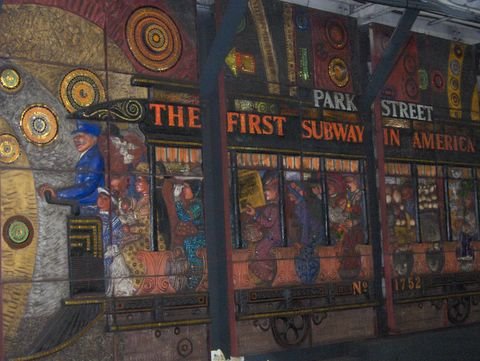
On my way to the Boston Public Library I took a picture of this mosaic located at Park Street station. It reminds passengers that the first underground subway in America was built in Boston. This station is part of the green line which has the oldest tunnel running along Tremont Street. It opened on September 1st, 1897. The Boston subway system, known as the “T” because of the logo from MBTA (Massachusetts Bay Transportation Authority), is divided into 4 branches: green, red, orange and blue.
En allant à la bibliothèque publique de Boston, j’ai pris en photo cette mosaïque à la station de métro Park Street. Elle rappelle aux voyageurs que le premier métro souterrain d’Amérique du Nord a été construit à Boston. Cette station fait partie de la ligne verte qui possède le plus ancien tunnel construit sous Tremont Street. Elle a été inaugurée le 1er septembre 1897. Le métro de Boston, plus connu sous le nom de “T” en raison du logo du MBTA (Massachusetts Bay Transportation Authority), est divisée en 4 lignes : verte, rouge, orange et bleu.
Posted by
Alex
at
12:11 AM
8
comments/commentaires
![]()
![]()
Apr 16, 2006
Rodeo Drive
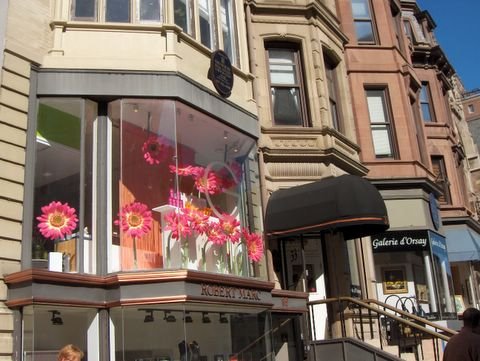
Newbury Street, also known as “Rodeo Drive” is one of the fanciest streets of Boston and the best place for window shopping. You can find there antiques stores, art galleries, fine boutiques, beauty salon and restaurants in a charming historical district. All the streets that cross Newbury Street, starting from the Boston Common are arranged in alphabetical order as planed in the 19th century.
Newbury Street, aussi appelée “Rodeo Drive” est une des rues les plus chics de Boston et le meilleur endroit pour faire du lèche-vitrine. On peut y trouver des antiquaires, des galeries d’art, des boutiques de luxe, des instituts de beauté et des restaurants dans un quartier historique plein de charme. Toutes les rues qui coupent Newbury Street, au départ du Boston Common ont été attribuées par ordre alphabétique, selon un urbanisme planifié au 19e siècle.
Posted by
Alex
at
5:38 PM
12
comments/commentaires
![]()
![]()
Apr 9, 2006
Remembering Boston firefighters
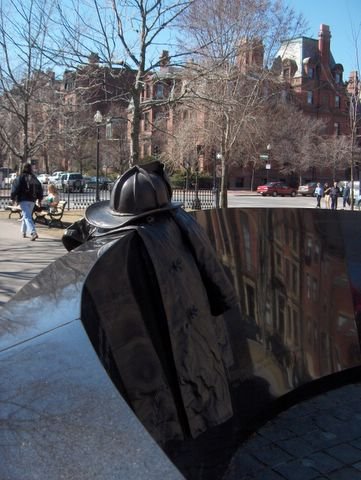
A memorial on Boston’s Commonwealth Avenue honors nine brave firemen who died there, in June 17th 1972. Ted Clausen, and Peter White created this bronze sculpture twenty five years after that tragic night. The fire occurred at Hotel Vendome located at the corner of Commonwealth Avenue and Dartmouth Street. It was the worst loss of life experienced by the Boston fire department. The luxurious Victorian hotel was built in 1871 and was the first public building in Boston to have electricity in 1882.
Un mémorial sur l’Avenue Commonwealth à Boston honore la mémoire de neuf pompiers courageux morts à cet endroit le 17 juin 1972. Ted Clausen et Peter White ont réalisé cette sculpture en bronze vingt-cinq ans après cette nuit tragique. Le feu a ravagé l’Hôtel Vendome situé à l'angle de L’avenue Commonwealth et de la rue Dartmouth. Ce furent les plus grosses pertes humaines jamais connues par les pompiers de Boston. Le luxueux hôtel victorien a été construit en 1871 et était le premier immeuble public à Boston à avoir l’électricité en 1882.
Posted by
Alex
at
6:10 PM
4
comments/commentaires
![]()
![]()
Apr 2, 2006
Mural Who’s Who
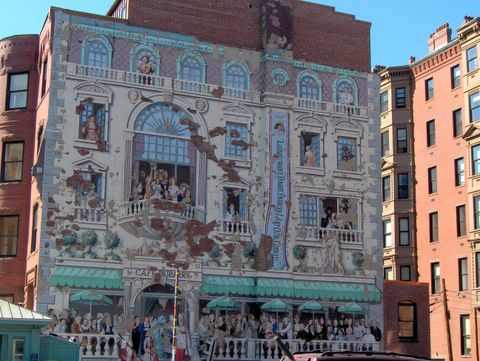
In 1991, Joshua Winer, a specialist in architectural murals realized this “trompe l’oeil” on Newbury Street, where the “Du Barry restaurant” used to be. This painting recalls the past with famous historical figures such as JFK, Babe Ruth, Isabella Gardner, Paul Revere, Graham Bell, Bette Davis, Picasso, Rembrandt and many more. You will also notice “La Baigneuse” d’Ingres and this inspiring French banner: “Laissez chaque homme exercer l’art qu’il connaît” (Let each man exercise the art he knows best).
En 1991, Joshua Winer, un spécialiste des peintures murales a réalisé ce trompe l’œil dans Newbury Street, là où se trouvait auparavant le restaurant Du Barry. Cette peinture évoque le passé avec des personnages historiques célèbres. On peut y reconnaître : JFK, Babe Ruth, Isabella Gardner, Paul Revere, Graham Bell, Bette Davis, Picasso, Rembrandt et beaucoup d’autres. Vous remarquerez aussi « La Baigneuse » d’Ingres ainsi que cette inspirante banderole écrite en français : “Laissez chaque homme exercer l’art qu’il connaît”.
Posted by
Alex
at
7:20 PM
10
comments/commentaires
![]()
![]()

